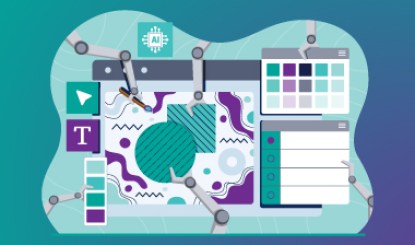Dispatches from a Designer Who Hasn’t Lost His Job to AI
“Robots take your job yet?”

If you’re a creative (like I am) and headed into the holiday season (like we all are), get ready: It’s what Uncle Denny might ask you over the punch bowl this year.
In Uncle Denny’s defense, though, the question is not out of left field. Artificial intelligence has been the talking point of 2023, and we can all admit it’s still hazy, and maybe even a little scary.
But something interesting has happened here at Hammer Marketing since Chat GPT debuted in late 2022: Not only have we designers kept our jobs (woot!); we have woven AI tools into our workflow…and discovered they feel nothing like the apocalypse. Instead, they feel more like the early days of every other breakthrough tool we’ve worked with over the years (and trust us, there have been many, including many we still use today).
In short, we’re cautiously optimistic that AI’s not replacing us, but is rather a) shifting up decision-making and focus, and b) putting welcome pressure on us designers to be that much more creative.
Here’s a metaphor. It’s not apples to apples but illustrates where we think AI in design might be heading.
Stock Imagery: It’s Complicated
Remember when digital stock photos and video libraries were new?
Overnight, creatives had access to almost all of the imagery they’d ever need – affordably, at their fingertips! Why splurge on a photo shoot when you could get the good enough stock alternative for pennies on the dollar?!
Just like that, stock imagery was everywhere. Sometimes you’d see stock footage in a TV spot one day… only to see the same footage again in a true crime documentary days later.
Consumers caught on. Before long, stock went from trade secret to down market of most brands’ intended messaging, forcing creatives to rethink its role. To be clear, there’s still a place for stock imagery in content. Now, though, it’s used more sparingly and more thoughtfully, often complemented and surrounded by custom elements that help offset its, well, stockness.
Maybe you see where this is going.
Our Hot Take
So far, AI has been a great tool for our design team, helping us save time, produce more, and occasionally even create work that’s objectively better than what we would have created without AI.
Say a client wants an Art Nouveau illustration of a dog. Rather than draft three original concepts from scratch, now we can use AI as a starting point for not just three but maybe a dozen dogs, then use our human skills to take each one from good to great. Or we can show the client an awesome art nouveau dog generated entirely by AI and create a unique world around it that exceeds what we ever could’ve done if we’d spent our time hand-drawing Fido (Pierre?) from scratch.
Here are the three AI tools our design team is using at Hammer Marketing – and a little about how we’re using them:
- Photoshop’s AI: Before, our team spent a lot of time searching for right-fit stock photos to effect. With Adobe Photoshop’s AI addition, a text prompt results in unique AI-generated imagery that usually hits the mark.
Photoshop AI’s generative fill tool saves time when right-fit images don’t quite fit aspect ratio requirements. Before AI, we filled in backgrounds by piecing together bits of the image using Photoshop’s clone stamp and other tools. Now, generative fill can create a convincing background alternative much faster. - Illustrator: Adobe Illustrator’s new AI feature lets us readily create custom icons, vector graphics, and patterns via text prompts. Like Photoshop, searching here is faster, too: Previously, designers had to sift through a lot of stock vector graphics. Now, Illustrator AI generates clear winners, cutting search time while providing strong starting points.
- Chat GPT: Most designers aren’t trained writers. Still, we historically had to decide between lorem ipsum placeholder copy in designs (which fails to sell an experience) or taking a stab at copy that might get us laughed out of a room! It’s why designers like me love Chat GPT’s ability to generate headlines, body copy, and captions for our works-in-progress and pitches. With it, our colleagues and clients can see some semblance of decent copy in early designs, which goes a long way toward easier visualization.
And the Drawbacks
Our Hammer team strive to be thoughtful about AI adoption – and cognizant of areas where it falls short. Here are a few:
- AI-generated photos always have issues. People’s faces and hands are wonky and various elements just don’t land right. This is where designers’ skill and attention to detail are vital in building upon and amending AI creations.
- AI inevitably produces some robotic results, which, yes, audiences notice, whether it’s images, graphics, or copy. This is all the more reason to treat AI generations as a “rough draft” and build upon them instead of assuming they’ll be good enough.
- There’s a threat of lost skills. If we rely too heavily on AI, some design skills might fall by the wayside. Sometimes it’s just better to pick up a pencil and sketch instead of taking it to a robot! Other times you need those sketching skills when AI fails!
Want to work with the team that uses AI – but also keeps it in its rightful place? Reach out – we love talking design capabilities! We’ll even use our human voices.

